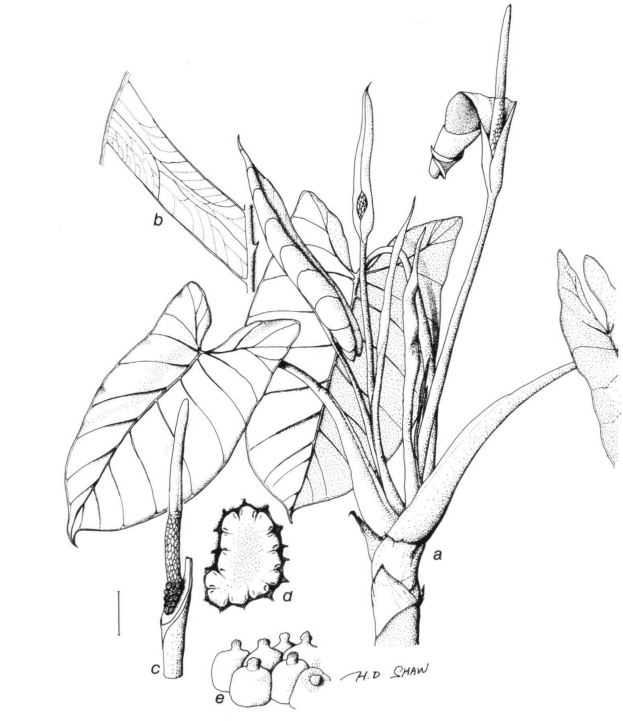ALOCASIA SIMONSIANA
ORIGINAL DESCRIPTION:
Ab Alocasia brisbanensis (F.M. Bailey) Domin statura minore, lamina folii glauca, synandrio non lineario, interstitio sterili brevissimo differt.
Typus: Cult. Hort. Reg. Bot.Sydney (Ace. No. 905114) ex Papua New Guinea, West Sepik Province, Vanimo, 27th April 1993, Dearden & Hay 7070 (NSW, holo).
SYNONYMS: N/A
DISTRIBUTION: New Guinea
CLIMATE: Tropical humid climate
Humidity is moderate throughout the year, ranging from 60% to 70%
Temperature is varies between the seasons - within the range of 48°F/9°C to 88°F/31°C during the day. Minimum temperatures never dip below 45°F/7°C
Rainy and humid season (October to May) and a dry season between June and October. The average annual rainfall is 1,200 mm
ECOLOGY: Lowland rainforest floor
SPECIES DESCRIPTION:
Moderately robust herb to c. 1 m tall; stem erect to c. 40 cm long, c. 4 cm diameter, clothed in old leaf bases; leaves c. 5 together; petiole to c. 30 cm, with scattered glands on the adaxial surface, sheathing in the lowerthird to one half, the wings of the sheath persistent; blade sagittate, dull blue-green adaxially, paler abaxially, somewhat coriaceous; anterior lobe to 25 cm long, c. 21 cm wide, the tip apiculate, with c. 7 primary veins on either side of the anterior costa diverging at c.50 degrees; primary venation adaxially raised towards the midrib, impressed towards the margin, abaxially prominent and darker green than the lamina; secondary venation faint abaxially and adaxially, not or hardly raised, diverging at c. 60-80 degrees and forming rather poorly defined intercostal collective veins; posterior costae to c. 13 cm long, diverging at c. 90-120 degrees, with laminato the sinus, but not peltate except in juveniles; posterior lobes bluntly acute
INFLORESCENCE:
Inflorescences strongly fragrant, paired, subtended by cataphylls bearing reduced petioles and rolled blades; peduncle resembling the petioles, to c. 30 cm long, erect; spathe c. 12 cm long, lanceolate, very weakly constricted about a third of its length from the base, opening above, at and below the constriction at anthesis, so that a distinct lower chamber is not or hardly perceptible, green throughout; lower third persistent after anthesis; limb erect at female anthesis, then reflexed and contorted, leathery, marcescent after male anthesis; spadix c. 10 cm long; female zone c. 1.8 cm long, adnate to the spathe for most of its length, c. 7 mm diameter; pistils globose, c. 2 mm diameter; stigmas button-like to weakly 4-lobed, raised on very short styles; ovary unilocular; ovules anatropous; sterile interstice a single whorl of well differentiated synandrodia without thecae; male zone c. 7-8 mm diameter at base, c. 4 mm diameter distally, c. 3.5 cm long; synandria (2-)4-8-staminate, approximately rhomboid, the outline irregular owing to the anthers being joined only adaxially, not laterally, c. 3-4 mm long, c. 2 mm wide; anthers opening by apical pores; appendix tapering gradually to the tip, more abruptly to the base, orange-yellow, c. 4.5 cm long, c. 5 mm diameter near base, minutely and irregularly tessellated by poorly differentiated synandrodia; fruit and seed unknown.
VARIEGATED FORMS: N/A
ETYMOLOGY: Alocasia simonsiana is named for Ashley Mark Simons, architect, who died of AIDS on March 14th, 1993 at the age of thirty-five.
NOTES:
CULTIVARS: N/A
HYBRIDS: N/A



